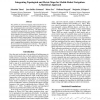Free Online Productivity Tools
i2Speak
i2Symbol
i2OCR
iTex2Img
iWeb2Print
iWeb2Shot
i2Type
iPdf2Split
iPdf2Merge
i2Bopomofo
i2Arabic
i2Style
i2Image
i2PDF
iLatex2Rtf
Sci2ools
AAAI
1998
1998
Integrating Topological and Metric Maps for Mobile Robot Navigation: A Statistical Approach
The problem of concurrent mapping and localization has received considerable attention in the mobile robotics community. Existing approachescan largely be grouped into two distinct paradigms: topological and metric. This paper proposes a method that integrates both. It posesthe mappingproblem as a statistical maximum likelihood problem, and devises an efficient algorithm for search in likelihood space. It presents an novel mapping algorithm that integrates two phases: a topological and a metric mapping phase. The topological mapping phasesolves a global position alignment problem between potentially indistinguishable, significant places. The subsequent metric mapping phase produces a fine-grained metric map of the environment in floating-point resolution. The approach is demonstrated empirically to scale up to large, cyclic, and highly ambiguous environments.
| Added | 01 Nov 2010 |
| Updated | 01 Nov 2010 |
| Type | Conference |
| Year | 1998 |
| Where | AAAI |
| Authors | Sebastian Thrun, Jens-Steffen Gutmann, Dieter Fox, Wolfram Burgard, Benjamin Kuipers |
Comments (0)

